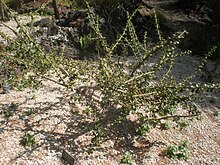Pereskiopsis
| Pereskiopsis | |
|---|---|

| |
| Pereskiopsis rotundifolia | |

| |
| Pereskiopsis diguetii in the Jardín Botánico de la UNAM, México | |
| Scientific classification | |
| Kingdom: | Plantae |
| Clade: | Tracheophytes |
| Clade: | Angiosperms |
| Clade: | Eudicots |
| Order: | Caryophyllales |
| Family: | Cactaceae |
| Subfamily: | Opuntioideae |
| Tribe: | Cylindropuntieae |
| Genus: | Pereskiopsis Britton & Rose |
| Species | |
Pereskiopsis is a genus of cactus (family Cactaceae) in the subfamily Opuntioideae. Unlike typical cacti, it has persistent fleshy leaves. The genus name refers to its resemblance to the genus Pereskia. Most species are found in Mexico south through Guatemala to Honduras, with one species in Bolivia. The incorrect spelling Peireskiopsis has also been used.
Description
Species of Pereskiopsis do not have the typical appearance of most cacti, including those in the subfamily Opuntioideae to which it belongs, since they have persistent fleshy leaves. They mostly have a shrubby or treelike growth habit, although some scramble or climb. Their stems have a round cross section and are not divided into segments. Their leaves are flat, succulent and generally long-lasting, and of various shapes, including elliptical and almost round. The characteristic areoles of cacti are present, and usually have glochids marking them as members of the Opuntioideae as well as needle-like spines. Their flowers resemble those of the genus Opuntia, with petals that open widely during the day. The fruits, which have few seeds, are fleshy and often have glochids.[1]
Taxonomy
The genus was described by Nathaniel Lord Britton and Joseph Nelson Rose in 1907.[2] Species known at that time had been variously placed in either Opuntia or Pereskia.[1] Two were first described in Pereskia in 1828, and transferred to Opuntia in 1898 under the section Pereskiopuntia.[3] The genus name means like Pereskia, being derived from the genus name Pereskia plus the Greek-derived ending -opsis meaning 'appearance'. Pereskia is named after Nicolas-Claude Fabri de Peiresc, a 16th-century French botanist.[1] Some sources have used the incorrect spelling Peireskiopsis.[4]
Phylogeny
Pereskiopsis is placed in the tribe Cylindropuntieae of the subfamily Opuntioideae. A 2016 molecular phylogenetic study of the tribe suggested the relationships shown in the following cladogram, where the genera Quiabentia and Pereskiopsis are basal to the main clade of Grusonia and Cylindropuntia. However, only two species of Pereskiopsis were included, and the status of Micropuntia pulchella remains uncertain. The author of the study suggested it be recognized as Micropuntia pulchella, although it could be another species of Pereskiopsis. However, M. pulchella has deciduous leaves, unlike the persistent leaves characteristic of Pereskiopsis.[5]
| Cylindropuntieae |
| ||||||||||||||||||||||||
Species
As of January 2023, Plants of the World Online accepted seven species:[2]
| Image | Scientific name | Distribution |
|---|---|---|
 |
Pereskiopsis aquosa (F.A.C.Weber) Britton & Rose | Mexico |
| Pereskiopsis blakeana J.G.Ortega | Mexico (Sinaloa, Durango, Michoacán) | |
| Pereskiopsis brandegeei Britton & Rose | Mexico (Baja California Sur) | |
 |
Pereskiopsis diguetii (F.A.C.Weber) Britton & Rose | Mexico, Bolivia |
| Pereskiopsis kellermanii Rose | Guatemala, Honduras, Mexico | |
 |
Pereskiopsis porteri (Brandegee ex F.A.C.Weber) Britton & Rose | Mexico (Sinaloa to Durango and Nayarit) |
| Pereskiopsis rotundifolia (DC.) Britton & Rose | Mexico |
Distribution
Species of Pereskia are native from Mexico south through Guatemala to Honduras, with one species, Pereskiopsis diguetii, also being found in Bolivia.[6][7]
Cultivation
Pereskiopsis species are not often cultivated as ornamental plants. Seedlings are used as grafting stock because of their narrow stem and vigorous growth.[8]
References
- ^ a b c Anderson, Edward F. (2001), "Pereskiopsis", The Cactus Family, Pentland, Oregon: Timber Press, pp. 572–574, ISBN 978-0-88192-498-5
- ^ a b "Pereskiopsis Britton & Rose - Plants of the World Online". Plants of the World Online. Retrieved 2023-01-30.
- ^ Britton, N.L. & Rose, J.N. (1907), "Pereskiopsis, a new genus of Cactaceae", Smithsonian Miscellaneous Collections, 50: 331–334, retrieved 2021-06-19
- ^ "Peireskiopsis Vaupel", The Interim Register of Marine and Nonmarine Genera, retrieved 2021-06-20
- ^ Bárcenas, Rolando T. (2016), "A molecular phylogenetic approach to the systematics of Cylindropuntieae (Opuntioideae, Cactaceae)", Cladistics, 32 (4): 351–359, doi:10.1111/cla.12135, PMID 34740297, S2CID 86139803
- ^ "Pereskiopsis Britton & Rose", Plants of the World Online, Royal Botanic Gardens, Kew, retrieved 2021-06-19
- ^ "Pereskiopsis diguetii (F.A.C.Weber) Britton & Rose", Plants of the World Online, Royal Botanic Gardens, Kew, retrieved 2021-06-20
- ^ Pilbeam, John (1987), "Pereskiopsis B. & R.", Cacti for the Connoisseur : A Guide for Growers & Collectors, London: Batsford, p. 129, ISBN 978-0-7134-4861-0
